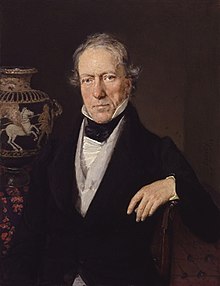William Martin Leake

William Martin Leake / liːk / (born January 14, 1777 in London , † January 6, 1860 in Brighton ) was an English army officer and archaeologist .
Life
William Martin Leake came from a respected family resident at Thorpe-Hall near Colchester in Essex . Raised at the Royal Military Academy at Woolwich , he served for four years in the West Indies as a naval artillery officer and was then sent to Constantinople by the British government to instruct the Ottomans in naval artillery. A trip through Asia Minor to Cyprus , where the British fleet was moored, in 1800 awakened a tendency towards the old topography. In 1801 he moved with the Turkish army through the desert to Egypt and, after the French had withdrawn there, he was commissioned to measure the Nile valley down to the cataracts. But when he was supposed to bring the Elgin Marbles from Athens to England by sea , he lost all his maps and records when his ship sank off Kythira . Shortly after arriving in the British Isles in 1804, he was hired to record the coast of Albania and Morea to assist the Ottomans in any attack by the French from Italy, and he used this expedition to explore ancient sites and collect a valuable collection of coins and inscriptions.
After a war broke out between England and Turkey, Leake was captured in Thessaloniki in 1807 , but was released the same year, whereupon he received a diplomatic mission to Ali Pasha of Ioannina , whose full trust he won and in which he won more than one Lingered for the United Kingdom for a year . In 1810 he was granted an annual income of £ 600 for his services in Turkey. After he had retired from active service in 1815 with the rank of colonel, he lived only scientific occupation, in particular topographical and archaeological studies. For this purpose he undertook new trips to Asia Minor. He was a Fellow of the Royal Society and the Royal Geographical Society , a member of the Prussian Academy of Sciences and a corresponding member of the Institut de France . In 1839 he donated the marble sculptures he had collected in Greece to the British Museum ; his bronzes, vases, gems and coins were bought by Cambridge University in 1864 and exhibited in the Fitzwilliam Museum . He died in Brighton in early 1860 at the age of 83.
Fonts
- Researches in Greece , London 1814
- Topography of Athens , London 1821; 2nd ed., 2 vol., Cambridge 1841; German based on the 2nd English edition by Johann Georg Baiter and Hermann Sauppe , Zurich 1844; the section on the demes of Attika specially edited and supplemented by Westermann, Braunschweig 1840
- Journal of a Tour in Asia Minor , London 1824
- Travels in the Morea , 3 vols., London. 1830
- Travels in Northern Greece , 4 vols., Cambridge 1835
- Memoir of the island of Cos , in: Transactions of the Royal Society , 2nd section; Vol. 1, London 1843
- Peloponnesiaca , London 1846
- Greece at the end of twenty-three years' protection , London 1851
- Numismata hellenica , 3 vols., Cambridge 1854–59
- On some disputed questions of ancient geography , London 1857
literature
- John H. Marsden: A Brief Memoir of the life and writings of Lieutenant Colonel William Martin Leake , London 1864. Digitized
- William Martin Leake . In: Meyers Konversations-Lexikon . 4th edition. Volume 10, Verlag des Bibliographisches Institut, Leipzig / Vienna 1885–1892, p. 586.
- Leake, William Martin . In: Encyclopædia Britannica , 11th edition, 1910-11, vol. 16, p. 329.
Individual evidence
- ^ William Martin Leake (1777-1860) | The Fitzwilliam Museum. Retrieved April 2, 2020 .
| personal data | |
|---|---|
| SURNAME | Leake, William Martin |
| BRIEF DESCRIPTION | English archaeologist |
| DATE OF BIRTH | January 14, 1777 |
| PLACE OF BIRTH | London |
| DATE OF DEATH | January 6, 1860 |
| Place of death | Brighton |